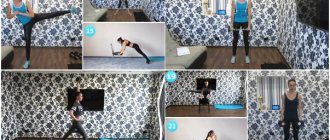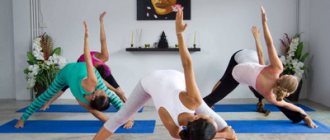What do we get by doing a cool-down after training?
When doing strength training in the gym, we expose our body to heavy loads. Microtraumas form in the muscles. Blood begins to circulate faster. Breathing quickens. Less oxygen enters the muscles, and lactic acid is formed. In a word, the body is under severe stress. And in order to return it to normal functioning, it is worth doing a set of calming exercises. What will this give us?
- Cooling down helps speed up muscle recovery during rest periods between workouts.
- Muscles become more elastic. Since the cool-down includes stretching exercises.
- Calms the nervous system, allowing a smooth transition from hard work to the normal rhythm of life.
- Walking or cycling for 3-5 minutes will reduce your heart rate. At the same time, there will be no strain on the cardiovascular system.
- Restoration of breathing, which helps speed up metabolism and the fastest supply of nutrients.
- Body temperature, which rises during intense training, decreases.
- Relieves muscle tension. Due to this, blood flow improves.
I think these advantages are enough to stay in the hall for 10 minutes.
Benefits of Cooling Down After Strength Training
- Accelerates muscle recovery, muscle growth and helps increase athletic performance.
- Makes muscles more elastic, which naturally prevents their stiffening, and therefore prevents pain and fatigue from constant contraction.
- Calms the nervous system after stress to the body - physical activity.
- Improves and accelerates the transport of nutrients to the muscles, which is especially important for nourishing muscles after workouts.
- Gradually reduces the pulse, which has a beneficial effect on the cardiovascular system, without overloading it with changes in heart rate.
Building a Cool Down
The classic cool down consists of two stages:
Low-intensity exercise (cardio and breathing exercises)
Allows you to reduce your pulse to a normal rhythm, lower your body temperature and restore breathing. For this stage, the following types of loads are suitable:
- Walking at a fast or moderate pace, turning into an easy run. This is especially true when training outdoors. In the gym, a treadmill is used for these purposes.
- Riding an exercise bike. You should not select high-intensity programs. Our task is to recover after training, and not to start a new one.
- Towing a pear in quiet mode. If you love this sport, then please use it to the benefit of your body.
- Jumping rope. This type of cardio will not only improve blood circulation and calm breathing. But it will also help strengthen your calves. Don't be overzealous. We work in a calm mode.
- You can use the exercises from the WARM-UP. Paying special attention to the muscles and joints involved in this workout.
- Swimming. Now most modern halls are equipped with swimming pools. Therefore, if you like to swim after training. Then you can rest assured that you will automatically complete one of the cool-down phases.
- Breathing exercises from yoga. There are a lot of these practices. Therefore, to master them, it is better to turn to a professional. If this is not possible, try doing the VACUUM exercise.
The first stage is designed to last 3-5 minutes. They will be enough for the necessary changes to occur in the body. But this does not mean that you cannot allocate more time to these exercises. The main thing to remember is that the purpose of their implementation is to calm the body, and not to overload it again.
Stretching
The second phase of the cool-down consists of a set of exercises to stretch the muscles. There are a lot of them. Basically, they are borrowed from athletics and yoga. The main task in these exercises is to take a position in which the muscle we need will be in the most stretched position. Therefore, you need to have at least a basic knowledge of anatomy. To do this, you can use THIS SECTION. In this article, we will look at several exercises for each muscle group. You can choose them or use your own. The main thing is to get the desired result.
HOW SHOULD YOU WARM UP?
Warm-up consists of several parts:
- Cardio
- Joint gymnastics
- Stretching
- Technical warm-up
- CARDIO
For a cardio warm-up, 3-6 minutes is enough for you.
Running or fast walking on a treadmill, exercise bike, ellipse, jumping rope. This pre-workout warm-up stage is intended for general preparation of the whole body for intensive work with basic exercises , remember, they are performed immediately after the warm-up. The blood accelerates, the pulse quickens, you can safely move on to the next stage of the warm-up before training.
A small life hack: you can skip this step if you get to the gym at a fast pace










